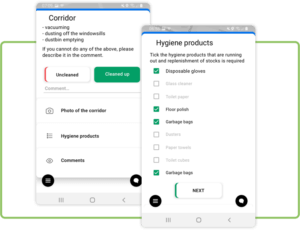
Checklists are crucial in many industries. They cover daily routines and ensure safety, consistency and standards. However, traditional paper checklists come with many limitations. An overwhelming amount of paperwork is not the only reason why your company should switch to digital checklists as soon as possible.
Due to the COVID-19 pandemic, 2020 is the year of digitisation. Even organisations that did not seem to be ready for it yet were forced to speed up their decision making. The changes concern both advanced processes and the simplest of everyday activities. One of them is paper checklists that are still commonly used within companies. Forms are filled in regularly, even every few hours and are a tool used daily in many workplaces. Why should they all be digitised?
Switching from the manual pen and paper method to a digital one brings more wins that you could expect.
Paper documents get destroyed or lost once in a while - it’s inevitable. Sometimes employees are imprecise when ticking an answer on the list. Or, the person who is reading the data and manually inputting it into the computer could be distracted. These situations can be easily eliminated when using a digital checklist.
Manually re-entering the data is undoubtedly time consuming and affects the efficiency of the whole process. This time could be spent differently, increasing productivity. Not to mention that digitised data available on the spot and accessible from any place improves further analytics.
The collected data is more accurate and more reliable. In TakeTask’s mobile app it is confirmed by location and a time stamp, so that managers can always be sure that the list was completed at the reported time, rather than being filled in after a while. The results are clear, without unnecessary paperwork.
The procedures to be completed are organised, structured and clear. Employees do not have to wonder which form to choose or remember when they have to complete it. They are notified by the upcoming task with a relevant checklist to be completed at the correct time. They are not going to leave any questions unanswered, having them conveniently in the smartphone.
Digital checklists free us from the limitations of paper. Conditional questions take the process of completing the list to a whole new level. There is no longer the need to skip questions that are not applicable at the present moment. The digital form leads us to the next relevant question itself, creating a unique question & answer path. This makes it easier and faster than ever to complete the task. Importantly, questions can be changed or updated at any time and the relevant people will have them on their smartphones immediately.
Checklists are a regular thing in many workplaces. They are completed very often and generate enormous paper consumption. Just in U.S offices alone, 12.1 trillion sheets of paper are used per year.
Paper reduction should be a target for every company. We hope that everybody understands that. Let’s also not forget that paper, printing, waste disposal and office space for documentation are costs that can be significantly reduced with digital checklists. Instead, devices (that the organisation probably already owns) are used. Also, in case of changes we don’t risk the waste of printed paper copies that will never be used.
One significant example of a company with a checklist need is Biedronka - a large food retail chain in Poland. With TakeTask they introduced digital checklists for the regional auditors of their stores. They use unified digitised forms to carry out regular audits in many different store locations. So far, they have performed them over 1,000 times in total, each of the controllers several dozen times. While performing the audit procedure, they check, among other things, the presence and location of marketing materials on the shop premises etc. Before the implementation of TakeTask all these tasks were performed manually on paper checklists.
Checklists are used in many industries for quality inspections, safety audits, opening and closing routines etc. Digitised forms improve efficiency and make life easier for employees. In big companies the best way to digitise their lists is to find the best available tool - a modern mobile app. At TakeTask we provide a comprehensive tool which enables easy and fast setup, distribution, confirmation and verification of different kinds of tasks. Checklists, as a starting point, can lead to an even bigger digital transformation.

Some companies implement narrow applications and digitalise one process with a specific checklist, others build their own systems but this path is not very flexible. Also, some organisations deploy very broad systems, however, this usually involves a large implementation. TakeTask combines the benefits of all these solutions, digitising specific processes, on its branded application with an independent server. This makes it easy to modify processes and - what is more - everything does not have to be implemented at once.
Would you like to know how it can work for your company?
Find out more about digital checklists provided by TakeTask.